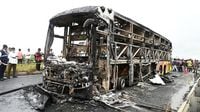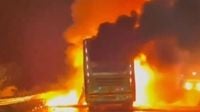In the early hours of October 24, 2025, a devastating tragedy unfolded on a highway near Chinnatekuru village, close to Kurnool district in Andhra Pradesh, southern India. A passenger bus, packed with 44 people journeying overnight between Hyderabad in Telangana state and Bengaluru in Karnataka state, became the scene of unimaginable horror after a motorcycle crashed into it from behind. Within minutes, the bus was engulfed in flames, leading to the deaths of at least 25 people and injuring several others, according to multiple sources including the Associated Press, BBC, and Sky News.
The accident occurred around 3:30 AM, a time when most passengers were fast asleep, oblivious to the danger that was about to erupt. Senior police official Vikrant Patil told the Associated Press, "The fire tore through the bus within minutes, trapping dozens of passengers as it sped along a highway near Kurnool district." The bus, a private vehicle, was traveling southbound and had just passed through the quiet village of Chinnatekuru, approximately 210 kilometers (130 miles) from Hyderabad.
According to police accounts and eyewitness reports, the motorcycle rammed into the speeding bus from behind, becoming lodged underneath. The bike was dragged for some distance, its metal scraping against the road and causing a shower of sparks. These sparks, tragically, ignited the bus's fuel tank. In a matter of moments, the vehicle was transformed into a raging inferno. Patil explained to Sky News, "As the smoke started spreading, the driver stopped the bus and tried to put the fire out by using a fire extinguisher, but the fire was so intense he couldn’t control it."
Panic quickly spread among the sleeping passengers as they awoke to the suffocating smoke and the searing heat of burning metal. Some managed to keep their wits about them. They smashed open windows and leapt to safety, sustaining only minor injuries. Others, tragically, were not so lucky. Many were trapped inside as the flames rapidly consumed the bus, and they were charred to death before help could arrive. The unidentified motorcyclist also lost his life in the crash.
Eyewitnesses described harrowing scenes, with passengers screaming for help and locals rushing to the burning bus, desperately trying to pull survivors from the wreckage. According to The Sun, forensic teams have been dispatched to identify the bodies, and DNA tests may be necessary due to the severity of the burns suffered by many victims. Eighteen passengers managed to escape the burning vehicle and are currently being treated for injuries. The full number of survivors and their conditions remain unclear as investigations continue.
Authorities responded swiftly. A team of forensic experts began working at the scene, sifting through the charred remains of the bus to determine the exact sequence of events and to aid in identifying the deceased. The police are also working to establish the identity of the motorcyclist and understand the circumstances that led to the collision. As reported by BBC, the bus was completely gutted by the fire, leaving little behind but a blackened shell.
The tragedy has drawn condolences from the highest levels of government. Prime Minister Narendra Modi expressed his grief, offering his condolences to the bereaved families. Andhra Pradesh’s highest elected official, N. Chandrababu Naidu, also extended his sympathies. President Droupadi Murmu called the incident "unfortunate" and said on X (formerly Twitter), "I extend my heartfelt condolences to the bereaved family members and pray for the speedy recovery of those injured."
This horrific incident is not an isolated one. It marks the second deadly bus fire in India in less than two weeks. Earlier in October, a passenger bus in Rajasthan caught fire after a suspected short circuit in the air conditioning system led to a gas leak, killing at least 20 people, including children. That tragedy, like the one near Kurnool, saw the bus rapidly engulfed in flames, giving passengers little chance to escape. The frequency of such deadly accidents has raised urgent questions about road safety and emergency preparedness on India’s highways.
India’s roads are among the world’s most dangerous, with thousands of fatalities reported each year due to a combination of factors: poorly maintained roads, speeding, inadequate vehicle safety standards, and sometimes sheer bad luck. The Kurnool bus tragedy underscores the lethal potential of even a single moment’s inattention or a mechanical failure. In this case, a single motorcycle crash set off a devastating chain of events that led to a catastrophic loss of life.
For the families of the victims, the loss is incalculable. Many of the deceased were likely traveling for work, family visits, or other everyday reasons. Overnight bus journeys are a common mode of travel in India, particularly for those who cannot afford flights or more expensive train tickets. The suddenness and violence of the tragedy have left communities in shock and mourning.
In the aftermath, the focus has turned to support for the survivors and the families of those lost. Local officials have promised that every effort will be made to identify the victims and provide assistance to their loved ones. The forensic investigation continues, with authorities determined to understand exactly how the fire spread so quickly and whether any safety protocols could have prevented such a high death toll.
Meanwhile, safety advocates are once again calling for stricter enforcement of road safety regulations, improved vehicle inspection standards, and better emergency response training for drivers and passengers alike. The recent string of bus fires has highlighted the urgent need for reforms—both in terms of infrastructure and public awareness—to prevent such tragedies from recurring.
As the investigation unfolds and families begin to grieve and rebuild, the Kurnool bus fire stands as a stark reminder of the fragility of life on India’s highways. For now, the nation mourns the lives lost and hopes for answers that might help spare others from similar heartbreak in the future.


